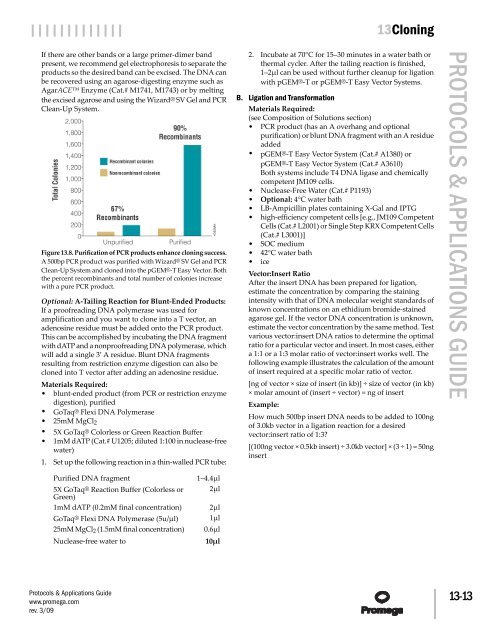Protocols and Applications Guide (US Letter Size) - Promega
Protocols and Applications Guide (US Letter Size) - Promega
Protocols and Applications Guide (US Letter Size) - Promega
Create successful ePaper yourself
Turn your PDF publications into a flip-book with our unique Google optimized e-Paper software.
||||||||||||| 13Cloning<br />
If there are other b<strong>and</strong>s or a large primer-dimer b<strong>and</strong><br />
present, we recommend gel electrophoresis to separate the<br />
products so the desired b<strong>and</strong> can be excised. The DNA can<br />
be recovered using an agarose-digesting enzyme such as<br />
AgarACE Enzyme (Cat.# M1741, M1743) or by melting<br />
the excised agarose <strong>and</strong> using the Wizard® SV Gel <strong>and</strong> PCR<br />
Clean-Up System.<br />
Figure 13.8. Purification of PCR products enhance cloning success.<br />
A 500bp PCR product was purified with Wizard® SV Gel <strong>and</strong> PCR<br />
Clean-Up System <strong>and</strong> cloned into the pGEM®-T Easy Vector. Both<br />
the percent recombinants <strong>and</strong> total number of colonies increase<br />
with a pure PCR product.<br />
Optional: A-Tailing Reaction for Blunt-Ended Products:<br />
If a proofreading DNA polymerase was used for<br />
amplification <strong>and</strong> you want to clone into a T vector, an<br />
adenosine residue must be added onto the PCR product.<br />
This can be accomplished by incubating the DNA fragment<br />
with dATP <strong>and</strong> a nonproofreading DNA polymerase, which<br />
will add a single 3′ A residue. Blunt DNA fragments<br />
resulting from restriction enzyme digestion can also be<br />
cloned into T vector after adding an adenosine residue.<br />
Materials Required:<br />
• blunt-ended product (from PCR or restriction enzyme<br />
digestion), purified<br />
• GoTaq® Flexi DNA Polymerase<br />
• 25mM MgCl2<br />
• 5X GoTaq® Colorless or Green Reaction Buffer<br />
• 1mM dATP (Cat.# U1205; diluted 1:100 in nuclease-free<br />
water)<br />
1. Set up the following reaction in a thin-walled PCR tube:<br />
Purified DNA fragment<br />
5X GoTaq® Reaction Buffer (Colorless or<br />
Green)<br />
1mM dATP (0.2mM final concentration)<br />
GoTaq® Flexi DNA Polymerase (5u/µl)<br />
25mM MgCl2 (1.5mM final concentration)<br />
Nuclease-free water to<br />
<strong>Protocols</strong> & <strong>Applications</strong> <strong>Guide</strong><br />
www.promega.com<br />
rev. 3/09<br />
1–4.4µl<br />
2µl<br />
2µl<br />
1µl<br />
0.6µl<br />
10µl<br />
2. Incubate at 70°C for 15–30 minutes in a water bath or<br />
thermal cycler. After the tailing reaction is finished,<br />
1–2µl can be used without further cleanup for ligation<br />
with pGEM®-T or pGEM®-T Easy Vector Systems.<br />
B. Ligation <strong>and</strong> Transformation<br />
Materials Required:<br />
(see Composition of Solutions section)<br />
• PCR product (has an A overhang <strong>and</strong> optional<br />
purification) or blunt DNA fragment with an A residue<br />
added<br />
• pGEM®-T Easy Vector System (Cat.# A1380) or<br />
pGEM®-T Easy Vector System (Cat.# A3610)<br />
Both systems include T4 DNA ligase <strong>and</strong> chemically<br />
competent JM109 cells.<br />
• Nuclease-Free Water (Cat.# P1193)<br />
• Optional: 4°C water bath<br />
• LB-Ampicillin plates containing X-Gal <strong>and</strong> IPTG<br />
• high-efficiency competent cells [e.g., JM109 Competent<br />
Cells (Cat.# L2001) or Single Step KRX Competent Cells<br />
(Cat.# L3001)]<br />
• SOC medium<br />
• 42°C water bath<br />
• ice<br />
Vector:Insert Ratio<br />
After the insert DNA has been prepared for ligation,<br />
estimate the concentration by comparing the staining<br />
intensity with that of DNA molecular weight st<strong>and</strong>ards of<br />
known concentrations on an ethidium bromide-stained<br />
agarose gel. If the vector DNA concentration is unknown,<br />
estimate the vector concentration by the same method. Test<br />
various vector:insert DNA ratios to determine the optimal<br />
ratio for a particular vector <strong>and</strong> insert. In most cases, either<br />
a 1:1 or a 1:3 molar ratio of vector:insert works well. The<br />
following example illustrates the calculation of the amount<br />
of insert required at a specific molar ratio of vector.<br />
[ng of vector × size of insert (in kb)] ÷ size of vector (in kb)<br />
× molar amount of (insert ÷ vector) = ng of insert<br />
Example:<br />
How much 500bp insert DNA needs to be added to 100ng<br />
of 3.0kb vector in a ligation reaction for a desired<br />
vector:insert ratio of 1:3?<br />
[(100ng vector × 0.5kb insert) ÷ 3.0kb vector] × (3 ÷ 1) = 50ng<br />
insert<br />
PROTOCOLS & APPLICATIONS GUIDE 13-13
















